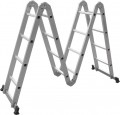Max. height
The maximum working height of the ladder. In models that do not have a footboard (see above), this parameter is usually indicated in the specifications for the total length of the stairs. It is worth noting here that the height of the upper step in such cases rarely corresponds to the working height to the nearest centimeter - firstly, the stairs are almost never strictly vertical, and secondly, the outermost steps are usually not on the very edge. However, in most cases this difference can be neglected. If the design provides for a footboard, then the height is measured along it.
When choosing a ladder by height, it should be taken into account that the longer the structure, the greater its weight and, usually, the higher the price. Therefore, buying a model with a long length makes sense only when there is a real need for it.
Dimensions (folded) (LxW)
Ladder dimensions in fully folded position. The smaller they are, the more convenient the ladder will be in storage and transportation. Usually, only the length and width are indicated in the characteristics, because. the thickness of modern stairs is very small and in most cases it can be neglected; and in some models, only the length may be indicated at all — for the same reasons.
Base Width
The width of the stabilizer provided in the design of the stairs.
The stabilizer is a device placed at the base of the structure and playing the role of a support. The most popular type of such a device is a horizontal bar, which protrudes noticeably beyond the width of the staircase itself; but there are other options (even a part of the stairs extended downwards, which does not have additional details, can be considered a stabilizer). Anyway, the stabilizer makes the structure more stable and reduces the likelihood of lateral rollover. And the larger its width, the higher the stability. On the other hand, too wide stabilizers would be too bulky, so in most models this figure does not exceed 1 m; larger supports are found mainly in "large-caliber" ladders with a large height, from 7 m or more, as well as racks with a platform (see "Type").
Weight
The total weight of the ladder. On the one hand, the lighter the model you choose, the more convenient it will be to carry, the less effort will be expended. On the other hand, lighter weight means less material used in the construction of the stairs, and this can adversely affect reliability. Therefore, it is worth choosing an option for this parameter depending on the planned features of the application. If the expected load on the ladder is significantly lower than the maximum, then you can not pay close attention to the weight. But if you have doubts and/or plan to work in difficult conditions with a heavy load, you should choose the more massive one from two models with the same characteristics. It is unlikely that this will seriously affect the cost of forces, but the risk of breakage and a dangerous fall will decrease significantly.

